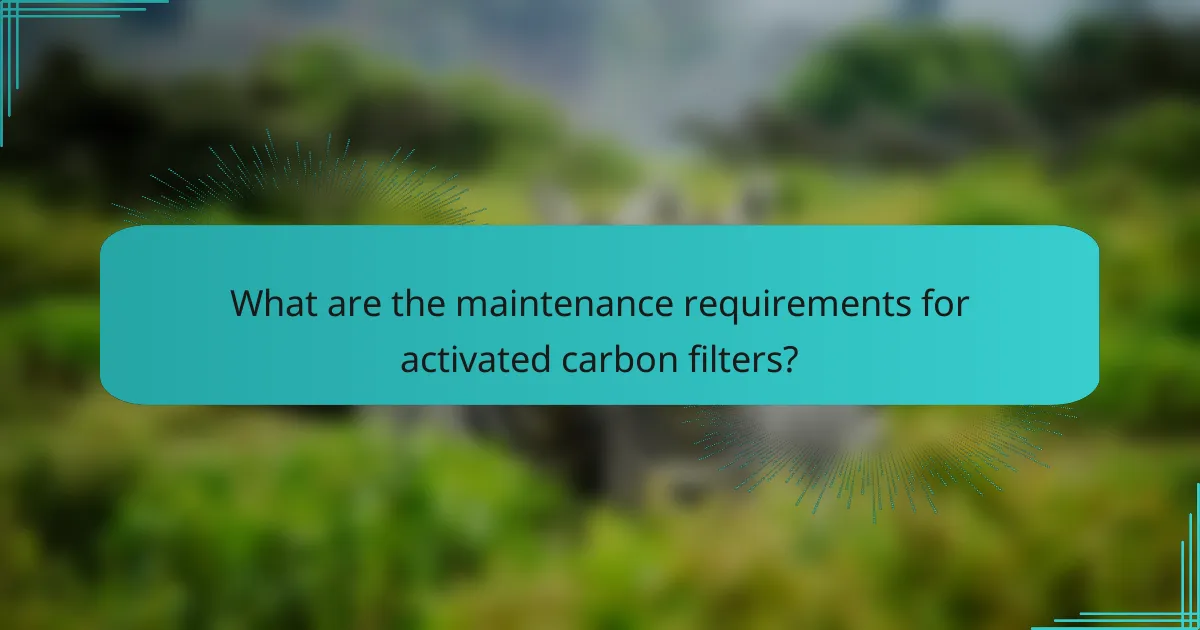Activated carbon filters are an effective solution for removing various contaminants from air and water, including volatile organic compounds and chlorine. With a lifespan ranging from 6 months to 2 years, their performance can be optimized through regular maintenance. Additionally, these filters are designed for easy installation, often allowing users to set them up in under an hour with minimal tools required.

How long do activated carbon filters last?
Activated carbon filters typically last between 6 months to 2 years, depending on usage and environmental conditions. Regular monitoring and maintenance can help ensure optimal performance throughout their lifespan.
Typical lifespan of activated carbon filters
The lifespan of activated carbon filters varies widely based on their application. For air purification, filters may last around 6 to 12 months, while those used in water filtration can last up to 2 years. It’s essential to check the manufacturer’s recommendations for specific products.
In many cases, filters that are used in high-contaminant environments will need replacement sooner. Regularly replacing filters helps maintain efficiency and effectiveness in contaminant removal.
Factors affecting filter lifespan
Additionally, temperature and humidity can affect performance. High humidity can lead to faster saturation, while extreme temperatures may degrade the carbon material. Regular monitoring can help identify when a filter needs replacement.
Signs of filter saturation
Recognizing signs of filter saturation is crucial for maintaining air and water quality. Common indicators include a noticeable decrease in airflow or water flow, as well as unpleasant odors that persist despite filtration. If the filter no longer effectively removes contaminants, it may be time for a replacement.
Some filters come with indicators that change color or signal when they need to be replaced. Regularly checking these indicators can help ensure that the filter operates efficiently and effectively.

What contaminants do activated carbon filters remove?
Activated carbon filters effectively remove a variety of contaminants from air and water, including volatile organic compounds (VOCs), chlorine, and certain heavy metals. Their porous structure adsorbs impurities, making them a popular choice for improving water quality and indoor air purity.
Common contaminants removed by activated carbon
Activated carbon filters are particularly effective against common contaminants such as chlorine, sediment, and organic compounds. They can also adsorb odors and tastes, which is why they are frequently used in water purification systems and air purifiers.
In addition to chlorine, activated carbon can capture pesticides, herbicides, and some heavy metals like lead and mercury. This makes them valuable for both residential and industrial applications where water quality is a concern.
Effectiveness against specific pollutants
The effectiveness of activated carbon filters varies depending on the type of pollutant. For instance, they are highly effective at removing chlorine and VOCs, often achieving removal rates exceeding 90%. However, their performance may diminish against certain inorganic contaminants, such as nitrates and fluoride, which require different filtration methods.
Factors such as contact time, temperature, and the specific type of activated carbon used can influence performance. It’s essential to choose a filter designed for the specific contaminants present in your water or air supply for optimal results.
Comparison with other filtration methods
Compared to other filtration methods, activated carbon filters excel in removing organic compounds and improving taste and odor. However, they are less effective against pathogens and certain minerals, which may require additional filtration systems like reverse osmosis or UV treatment.
When evaluating filtration options, consider the specific contaminants you need to address. For example, while activated carbon is excellent for chlorine and VOCs, a multi-stage system that includes sediment filters and UV light may be necessary for comprehensive purification.

How easy is it to install an activated carbon filter?
Installing an activated carbon filter is generally straightforward and can often be completed in under an hour. Most systems are designed for easy DIY installation, requiring minimal tools and expertise.
Installation steps for activated carbon filters
Begin by turning off the water supply and draining the system if necessary. Next, remove the existing filter or housing, ensuring to clean the area to prevent contamination. Then, insert the activated carbon filter according to the manufacturer’s instructions, making sure it fits snugly.
After securing the filter, reattach any housing or components and turn the water supply back on. Finally, check for leaks and run water through the filter for a few minutes to flush out any loose carbon particles.
Tools required for installation
The tools needed for installing an activated carbon filter typically include a wrench, screwdriver, and possibly a utility knife for cutting tubing. Depending on the system, you may also need Teflon tape to ensure a watertight seal.
Having a bucket or towel handy can help manage any spills during the process. Always refer to the specific installation manual for any additional tools that may be required for your particular model.
Common installation challenges
One common challenge is ensuring a proper fit, as some filters may not be compatible with existing plumbing. It’s crucial to check the specifications of both the filter and your plumbing system before starting the installation.
Another issue can arise from leaks, often caused by improper sealing or loose connections. To avoid this, double-check all fittings and use Teflon tape where necessary. If problems persist, consulting a professional may be advisable.

What are the maintenance requirements for activated carbon filters?
Activated carbon filters require regular maintenance to ensure optimal performance and longevity. This includes routine checks and timely replacement to effectively remove contaminants from air or water.
Regular maintenance tasks
Regular maintenance tasks for activated carbon filters include inspecting the filter housing for any leaks or damage and ensuring that the filter is securely in place. Cleaning the pre-filters, if applicable, can also enhance the overall efficiency of the system.
Additionally, monitoring the pressure drop across the filter can help identify when the filter is becoming clogged. Keeping a maintenance log can assist in tracking these checks and any necessary actions taken.
Frequency of filter replacement
The frequency of filter replacement largely depends on usage and the type of contaminants being filtered. Generally, activated carbon filters should be replaced every 6 to 12 months for optimal performance.
Factors such as water quality, air pollution levels, and the volume of air or water being filtered can influence replacement intervals. Regularly assessing the filter’s effectiveness can help determine the right timing for replacement, ensuring contaminants are adequately removed.

How do I choose the right activated carbon filter?
Choosing the right activated carbon filter involves evaluating your specific needs, including the contaminants you wish to remove, the filter’s lifespan, and ease of installation. Consider factors such as the filter’s capacity, the type of contaminants it targets, and any brand reputation for quality and reliability.
Criteria for selecting activated carbon filters
When selecting an activated carbon filter, first identify the contaminants present in your water or air. Common targets include chlorine, volatile organic compounds (VOCs), and odors. Look for filters that specify their contaminant removal capabilities and ensure they meet relevant standards.
Next, consider the filter’s lifespan, which can vary significantly based on usage and contaminant levels. Many filters last from several months to a few years, so choose one that aligns with your maintenance preferences. Additionally, assess the installation process; some filters are designed for easy DIY installation, while others may require professional help.
Brand recommendations for UK consumers
For UK consumers, brands like Brita, AquaCrest, and Waterdrop offer a range of activated carbon filters that are well-reviewed for their performance and reliability. Brita is particularly known for its pitcher filters, while AquaCrest provides a variety of options for different systems.
Another reputable option is the ZeroWater filter, which not only uses activated carbon but also features a five-stage filtration system for enhanced contaminant removal. Always check user reviews and product specifications to ensure the filter meets your specific needs and standards.

What are the future trends in activated carbon filtration?
Future trends in activated carbon filtration focus on enhancing efficiency, sustainability, and versatility. Innovations include advanced materials and technologies that improve contaminant removal while reducing environmental impact.
Filter lifespan
The lifespan of activated carbon filters typically ranges from several months to a couple of years, depending on usage and contaminant levels. Regular monitoring is essential to determine when a filter needs replacement, as performance can decline significantly once it reaches saturation.
To maximize filter lifespan, consider factors such as water quality, flow rate, and the specific contaminants being targeted. For instance, filters used in areas with high levels of chlorine may require more frequent changes compared to those in less contaminated environments.
Contaminant removal
Activated carbon filters are effective at removing a wide variety of contaminants, including chlorine, volatile organic compounds (VOCs), and certain heavy metals. Their adsorption capabilities make them suitable for both air and water purification applications.
When selecting a filter, it’s important to assess the specific contaminants present in your environment. Some filters are designed for particular substances, so understanding your needs can help in choosing the most effective solution.
Installation ease
Installing activated carbon filters is generally straightforward, often requiring minimal tools and expertise. Many filters are designed for DIY installation, making them accessible for homeowners and businesses alike.
Before installation, review the manufacturer’s instructions to ensure proper setup. Common pitfalls include improper sealing and incorrect placement, which can hinder filter performance. Taking the time to follow guidelines can lead to optimal filtration results.

